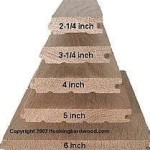How To Install Oak Flooring
Oak flooring is a popular choice for homeowners seeking a durable, aesthetically pleasing, and timeless flooring option. Its natural beauty, strength, and versatility make it suitable for a wide range of interior design styles. Installing oak flooring, whether solid or engineered, requires careful planning, preparation, and execution. This article provides a comprehensive guide to the process, covering essential steps from subfloor preparation to the final finishing touches.
Planning and Preparation
Successful oak flooring installation hinges on meticulous planning and thorough preparation. This stage sets the foundation for a smooth and professional-looking outcome. Neglecting these initial steps can lead to costly errors and unsatisfactory results.
Acclimation: A crucial aspect of preparation is acclimation. Oak flooring, like all wood products, expands and contracts with changes in temperature and humidity. Acclimation involves allowing the flooring material to adjust to the environment in which it will be installed. This process helps minimize the risk of buckling, gapping, or warping after installation. The duration of acclimation varies depending on the type of oak flooring (solid or engineered), the local climate, and the manufacturer's recommendations. Generally, solid oak flooring requires a longer acclimation period than engineered oak flooring, often ranging from three to seven days. The flooring should be laid out in the room where it will be installed, ensuring adequate air circulation around each plank. Maintain a consistent temperature and humidity level within the recommended range, typically between 60°F and 80°F and 30% to 50% relative humidity.
Subfloor Inspection and Preparation: The subfloor provides the foundation for the oak flooring. A level, clean, and dry subfloor is essential for a successful installation. The subfloor should be inspected for any signs of damage, such as cracks, rot, or water stains. Any necessary repairs should be completed before proceeding. The subfloor must also be level. Unevenness can cause the oak flooring to squeak, flex, or even break over time. A self-leveling compound can be used to correct minor imperfections. For more significant variations, shimming may be required. The subfloor must be thoroughly cleaned of all debris, including dust, dirt, nails, and staples. A vacuum cleaner and a scraper can be used to remove stubborn residue. The moisture content of the subfloor must also be checked using a moisture meter. Excessive moisture can lead to problems with the oak flooring, such as warping or mold growth. The moisture content should be within the range recommended by the flooring manufacturer.
Gathering Tools and Materials: Having the right tools and materials on hand will streamline the installation process and ensure professional results. Essential tools include a measuring tape, a pencil, a chalk line, a moisture meter, a circular saw or miter saw, a jamb saw or undercut saw, a tapping block, a rubber mallet, a flooring nailer or stapler (for nail-down or staple-down installations), construction adhesive (for glue-down installations), safety glasses, and knee pads. Necessary materials include the oak flooring itself, underlayment (if required), nails or staples (for nail-down or staple-down installations), construction adhesive (for glue-down installations), wood filler, and shoe molding or baseboards. Ensure all tools are in good working order and all materials are of high quality.
Installation Methods
Oak flooring can be installed using several methods, each with its own advantages and disadvantages. The choice of installation method depends on factors such as the type of oak flooring (solid or engineered), the subfloor material, and the homeowner's preferences. The most common installation methods are nail-down, staple-down, glue-down, and floating.
Nail-Down or Staple-Down Installation: This method involves securing the oak flooring planks directly to the wood subfloor using nails or staples. It is suitable for solid and engineered oak flooring installed over a wood subfloor. A flooring nailer or stapler is used to drive the fasteners through the tongue of each plank at a 45-degree angle. This method provides a secure and long-lasting installation. The nails or staples should be spaced according to the manufacturer's recommendations, typically every 6 to 8 inches. It's important to use the correct type and size of fasteners to avoid damaging the oak flooring. This method generally provides a more solid feel underfoot compared to floating floors.
Glue-Down Installation: This method involves adhering the oak flooring planks directly to the subfloor using construction adhesive. It is suitable for engineered oak flooring installed over concrete or wood subfloors. The adhesive is applied to the subfloor in a consistent layer using a notched trowel. The oak flooring planks are then pressed firmly into the adhesive, ensuring full contact. This method provides a stable and durable installation. It is crucial to use the correct type of adhesive recommended by the flooring manufacturer. The adhesive should be allowed to cure completely before walking on the floor. This method provides excellent stability and minimizes movement of the flooring.
Floating Installation: This method involves installing the oak flooring planks without directly attaching them to the subfloor. The planks are connected to each other using a tongue-and-groove system, creating a single, continuous surface that "floats" over the subfloor. An underlayment is typically installed between the oak flooring and the subfloor to provide cushioning, sound insulation, and moisture protection. This method is suitable for engineered oak flooring installed over concrete or wood subfloors. It is a relatively easy and quick installation method. However, it may not provide the same solid feel underfoot as nail-down or glue-down installations. The underlayment is a critical component, ensuring proper support and preventing moisture issues.
Step-by-Step Installation Guide
This section provides a detailed step-by-step guide to installing oak flooring, covering the essential steps from the initial layout to the final trim installation. The specific steps may vary depending on the chosen installation method.
Establishing a Starting Point: Determining the starting point is crucial for ensuring the oak flooring is installed straight and square. Begin by finding the longest, straightest wall in the room. This wall will serve as the reference point. Use a chalk line to mark a straight line parallel to the wall, leaving a gap of approximately 1/4 to 3/8 inch between the line and the wall. This gap allows for expansion and contraction of the oak flooring. The gap should be consistent along the entire length of the wall. Check the squareness of the starting line using a carpenter's square. Adjust the line as needed to ensure it is perfectly square to the adjacent wall.
Laying the First Row: Carefully position the first row of oak flooring planks along the starting line. The tongue side of the planks should face the starting line. Use shims to maintain the expansion gap between the planks and the wall. Secure the planks using the chosen installation method. For nail-down or staple-down installations, use a flooring nailer or stapler to drive fasteners through the tongue of each plank. For glue-down installations, apply construction adhesive to the subfloor and press the planks firmly into the adhesive. Ensure the planks are aligned precisely along the starting line. Any misalignment in the first row will propagate through the rest of the installation.
Continuing the Installation: Once the first row is securely in place, continue laying the remaining rows of oak flooring planks. Stagger the end joints of the planks in each row to create a visually appealing and structurally sound floor. Use a tapping block and a rubber mallet to gently tap the planks together, ensuring a tight fit. For nail-down or staple-down installations, maintain consistent fastener spacing. For glue-down installations, ensure full adhesive contact between the planks and the subfloor. Periodically check the alignment of the rows using a straight edge. Make any necessary adjustments to maintain a consistent layout. Cut planks to fit around obstacles such as doorways, pipes, and cabinets. Use a jamb saw or undercut saw to trim door casings to allow the oak flooring to slide underneath.
Installing the Final Row: Installing the final row of oak flooring planks often requires cutting the planks to fit the remaining space. Measure the distance between the last full row and the wall, remembering to account for the expansion gap. Cut the planks to the appropriate width using a circular saw or miter saw. Use a pull bar to gently pull the planks into place, ensuring a tight fit. Secure the planks using the chosen installation method. In some cases, it may be necessary to use construction adhesive in addition to nails or staples to secure the final row.
Finishing Touches: After the oak flooring is installed, remove the shims and install shoe molding or baseboards along the perimeter of the room. The shoe molding or baseboards will cover the expansion gap and provide a finished look. Use wood filler to fill any nail holes or gaps in the oak flooring. Sand the surface lightly to create a smooth finish. Apply a finish or sealant to protect the oak flooring from wear and tear. Follow the manufacturer's instructions for applying the finish or sealant. Allow the finish or sealant to dry completely before walking on the floor. Inspect the floor for any imperfections and make any necessary repairs.

How To Install Laminate Flooring For Beginners

How To Install Oak Hardwood Floors Young House Love

How To Install Hardwood Flooring For Beginners

How To Install Hardwood Flooring Step By Forbes Home

Installation Methods For Wooden Floor Craftedforlife

How To Install Hardwood Flooring The Home Depot
:strip_icc()/101206833-2e499ef612434b6b8ab6e5b62422a78f.jpg?strip=all)
How To Install Hardwood Floors

How To Install Lock Engineered Hardwood Flooring

How To Install Hardwood Flooring The Home Depot

Wood Floor Installation Diy Guide Ck
Related Posts








